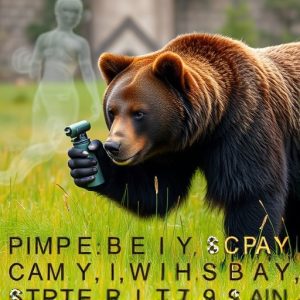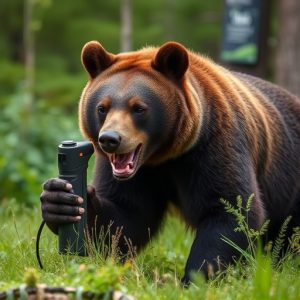Bear Attack Protection: Understanding Attraction & Choosing Effective Bear Spray
Bears, especially grizzlies and black bears, pose risks in wilderness areas due to their strong sens…….
Bears, especially grizzlies and black bears, pose risks in wilderness areas due to their strong sense of smell leading them to human food or trash. Understanding bear behavior is key for survival; they typically avoid humans unless threatened or seeking food. Bear spray, with 15-20% active ingredients like capsaicin or oleoresin capsicum (OC), is an effective defense mechanism against aggressive bears. Choosing the right bear spray involves checking labels and understanding specific active ingredient percentages tailored to regional bear types for optimal protection.
“In the vast wilderness, encountering a bear can range from an awe-inspiring moment to a life-threatening situation. Understanding bear behavior and equipping yourself with the right tools is paramount for wilderness survival. This article delves into the dynamics of bear attractions towards humans and explores the effectiveness of bear spray as a protective measure. We’ll also dissect what makes bear spray active ingredient percentage critical in ensuring its reliability, providing you with essential knowledge to navigate these encounters safely.”
- Understanding Bear Behavior and Their Attraction to Humans
- What is Bear Spray and How Effective Is It?
- Choosing the Right Bear Spray: Active Ingredient Percentage Matters
Understanding Bear Behavior and Their Attraction to Humans
Bears, especially grizzlies and black bears, are iconic symbols of wilderness. Understanding their behavior is crucial for survival in bear country. These powerful animals have a keen sense of smell, which often attracts them to human food or trash. They may also be curious or feel threatened, leading to potential attacks. It’s essential to know that bears prefer to avoid humans unless they perceive a threat or are looking for food.
Bear spray, a popular defense mechanism, is designed to deter bears through its high active ingredient percentage, typically around 15-20%. When used correctly, it creates a barrier of capsaicin that irritates the bear’s eyes and respiratory system, allowing you to escape. However, it’s just one tool in your survival kit; proper knowledge of bear habits and respecting their space is equally vital for your safety in the wilderness.
What is Bear Spray and How Effective Is It?
Bear spray, also known as bear repellent, is a crucial tool for wilderness survival and one of the primary defenses against bear attacks. It’s designed to deter bears by irritating their eyes and nasal membranes when sprayed directly at close range. The active ingredient in most bear sprays is capsaicin, derived from chili peppers, which can temporarily blind and disorientate bears, giving you valuable time to escape or play dead.
The effectiveness of bear spray depends on various factors, including the concentration of the active ingredient and proper usage. High-quality bear spray typically contains 15% to 20% capsaicin, ensuring maximum potency. This percentage, when combined with a well-aimed spray pattern that covers the bear’s face and eyes, can significantly reduce the risk of an attack. It’s important to remember that no single method guarantees complete protection, but combining bear spray with awareness, noise-making devices, and understanding bear behavior enhances your safety in bear country.
Choosing the Right Bear Spray: Active Ingredient Percentage Matters
When considering bear spray as a protection measure during wilderness survival, it’s crucial to understand that not all products are created equal. Choosing the right bear spray means understanding and prioritizing the bear spray active ingredient percentage. Common active ingredients include capsaicin, oleoresin capsicum (OC), and canola oil. Each has unique effectiveness levels against different bear species. For instance, OC is known for its high potency against black bears, while capsaicin offers broader spectrum protection.
The ideal bear spray active ingredient percentage typically ranges from 15% to 34%. This concentration ensures a strong enough irritant to deter aggressive bears. Lower percentages might not be sufficient to cause the desired effect, while significantly higher ones could lead to misdirection or even harm to the user. Always check product labels and consult with experts for recommendations tailored to specific regions and bear types you’re likely to encounter.
While understanding bear behavior and relying on deterrents like bear spray can significantly reduce the risk of attacks, it’s crucial to remember that no single method guarantees 100% protection. Choosing the right bear spray with a high active ingredient percentage (typically 20-35%) is a key step in self-defense. Always follow safety guidelines and be mindful of local regulations when venturing into areas known for bear activity. Staying informed, prepared, and aware is the best defense in these situations.


